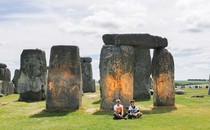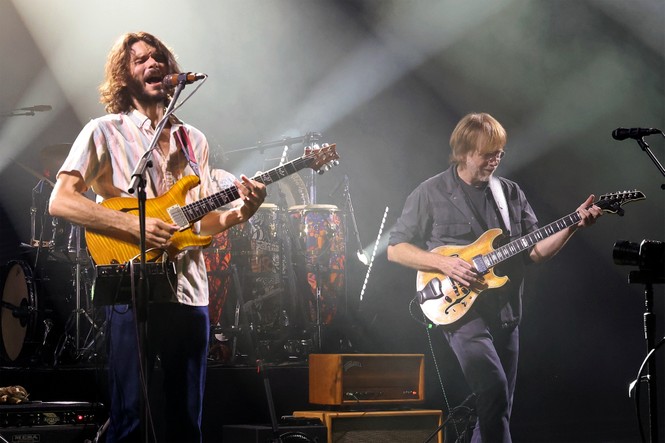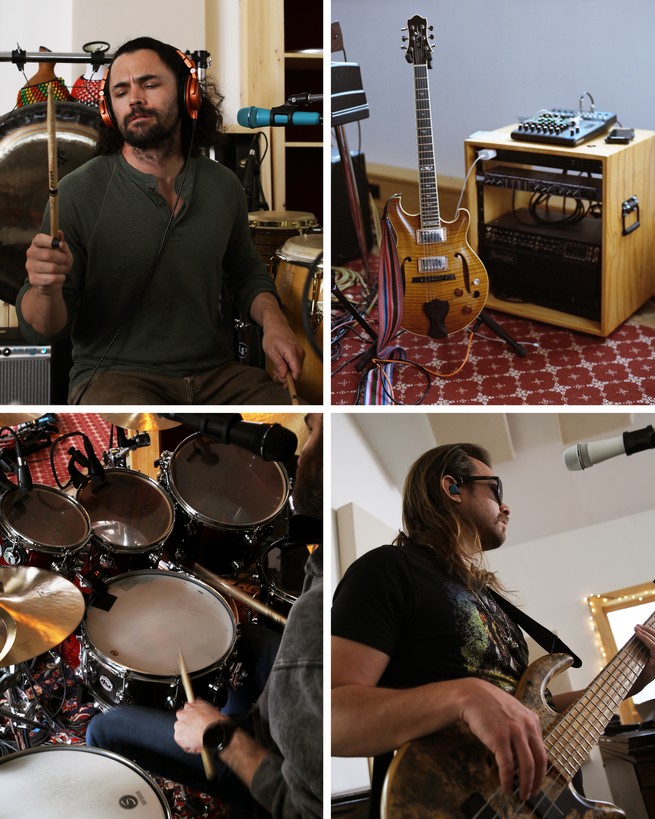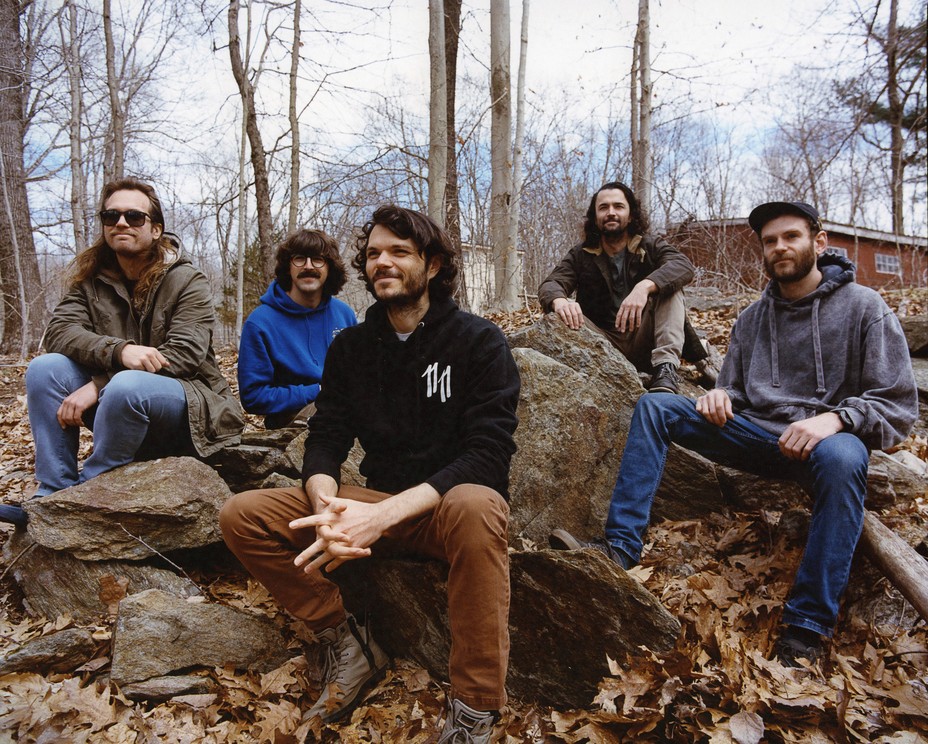The Improbable, Unstoppable Rise of Goose
13 min read
F
or the sake of brevity, let’s skip the first verse and the chorus. Let’s jump over some ambient noodling and the gradual building of musical tension. Let’s begin, in jam-band parlance, on a peak, a moment of sonic culmination. Let’s begin at Radio City Music Hall on June 25, 2022. Specifically, we’re two hours and 12 minutes into the evening when the house lights come up, a red-haired 57-year-old man with a guitar walks onstage, and all 6,000 people in attendance collectively lose their minds as they realize what they are witnessing.
The redhead is the Phish front man Trey Anastasio. But this isn’t a Phish show. The headliner tonight is Goose, a band of five 30-somethings in the midst of a meteoric rise. This is Goose’s second-straight sold-out show at Radio City; just three years and three days earlier, the band was playing at Kenny’s Westside Pub, in Peoria, Illinois.
In his first song with the band, Anastasio, one of the best guitarists of his or any era, holds back, letting Goose’s guitarist, Rick Mitarotonda, lead complex improvisations. As the pair continue to trade riffs, a grin appears on Anastasio’s face. Typically, a visitor of his stature would play just a couple of songs before taking a bow. But after two, he leans into Mitarotonda to whisper a few words the audience can’t hear. When the huddle breaks, Mitarotonda smiles wryly. “He’s gonna stay,” he tells the ecstatic crowd. They play together for another hour.
If you don’t know much about Phish, Goose, or the jam scene, the significance of Anastasio’s presence might be hard to parse. The Radio City show was a landmark moment for Goose—a signal to anyone with a passing interest in the genre that it was time to take the band seriously.
I will pause here to say that I am keenly aware that even a passing interest in this subject may be more than some readers will be able to muster. I’ve apologized enough for my musical proclivities over the years to know that jam band can be a freighted combination of words. It might bring up memories of patchouli oil and Hacky Sacks, of stoned liberal-arts grads arguing about which 16-minute version of Phish’s “Reba” is superior. Without hearing a note, you may have already made up your mind about Goose.
Then again, maybe not. Recently, I’ve found myself needing to apologize less often for my tastes: After years of stigma, the jam scene is enjoying something like mainstream acceptance. Last summer, Dead & Company—the latest incarnation of the Grateful Dead—sold out shows across the country and, according to The New York Times, made the Dead “a cultural touchstone again.” With John Mayer now installed as lead guitarist, the group has recruited a new generation of fans, many of whom weren’t even born when Jerry Garcia died, in 1995. Dead & Company and Phish are now packing audiences into the Sphere, the towering orb just off the Las Vegas Strip, whose spectacle is made for social-media sharing.
One reason for this renaissance is the stultifying nature of listening to music in the era of streaming dominance. Platforms such as Spotify seek to identify users’ tastes and then serve up more of the same. Jam bands, in contrast, are unpredictable by definition. In the mid-’60s, the Grateful Dead established an ethos of constant experimentation: No two live shows are ever the same, and, indeed, no performance of a given song is ever repeated. Each show is a feat of improvisation, and part of the appeal is witnessing this high-wire act alongside fellow travelers. Unlike the atomized experience of streaming music through a set of earbuds, following a jam band is a communal adventure. The music, in other words, is a powerful rebuke to the idea that our tastes can be analyzed, quantified, and satisfied by a computer.
Goose has been especially well positioned to benefit from a newfound openness to the jam scene. Whereas the Dead is a band with decades of esoteric lore and a sound forged in the ’60s, Goose is accessible and modern. The band’s influences are rooted in the indie and rock acts its members grew up admiring: the Red Hot Chili Peppers, Fleet Foxes, Bon Iver, Radiohead, and, yes, Phish.

Onstage, Goose builds little worlds. “I’m constantly looking to create something that I feel like I could get lost in,” Mitarotonda told me recently. In the middle of a song, he will conjure winding, hypnotic melodies, then weave them together with the notes and rhythms the four other men are playing. The band composes ephemeral songs within songs, bending genres along the way—plodding organ funk may give way to bright, searching major-key bliss rock. A distorted, menacing series of guitar riffs and bass lines may build to gnarly peaks before landing softly and ethereally. Or the band might break into one of its trademark reinterpretations of ’80s pop: Kenny Loggins’s “Danger Zone,” from the Top Gun soundtrack; Eddy Grant’s reggae-fusion hit “Electric Avenue.”
Jerry Garcia’s death tore a hole in the jam-band scene, creating a vacuum no one was ready to fill. Former members of the Grateful Dead played on, as did Phish and bands such as Widespread Panic, but no rightful heir had been named. The result was an immense pressure, especially on Phish and Anastasio, to absorb the audience and legacy of the Dead while preserving their own sound. In championing Goose, Anastasio was perhaps attempting to point a way forward, not just for the band, but for the now-resurgent genre. Dead & Company, too, has collaborated with Goose, offering the group its own imprimatur.
For all their recent success, Phish and Dead & Company are the past and present, not the future, of the scene. It may fall to Goose to be the group that escapes the confines of the old tie-dyed traveling circus, reimagines what a modern jam band can be, and awakens a wider audience to the endless possibilities and pleasures of improvised rock.
Goose officially became a band in 2014. The group slowly assembled its lineup by cobbling together Mitarotonda’s friends from Boston’s Berklee College of Music (founding drummer Ben Atkind) and his hometown of Wilton, Connecticut (the multi-instrumentalist Peter Anspach as well as the bassist Trevor Weekz, who looks like the chillest employee at your local ski shop). Anspach started as a Goose fan—and rival band leader—before joining in 2017. He embodies Goose’s nerdy energy: Onstage, he can be found behind an array of keyboards, a guitar slung over his back, bobbing up and down to the music. But Goose didn’t settle fully on its trademark sound until 2020, when it invited a longtime collaborator, the percussionist Jeff Arevalo, to come on full time. Arevalo can complicate a rhythm in a way that pushes a song into new territory.
The early days were a grind. Jam bands prove themselves on the road, and Goose spent multiple years playing 100-plus shows. There’s a word-of-mouth element to the scene: When fans hear the genuine article, the news travels. A bar gig can lead to a small college-town show, which can garner an invite to a festival—and the fan base grows.
Even when Goose was playing the smaller festival circuit, it maintained a prolific online presence, posting concert clips on YouTube, livestreaming almost daily via a subscription service, and making soundboard recordings of shows available, many of them for free, on platforms such as Bandcamp. Much of this was originally Anspach’s doing: He mastered the soundboard audio from shows and dutifully posted it to Bandcamp not long after coming offstage. As it’s grown, Goose has built out a team of videographers and directors who continue to livestream most shows—a concert film released nearly every night the band is on tour. In its own way, the band is updating a tradition started by the Dead, of making the band’s central output—live music—as available as possible.
The coronavirus pandemic arrived at a hinge point for the band’s popularity. Live music was essentially canceled—Goose, however, continued to play. It booked a slate of socially distanced shows at drive-in theaters, and streamed “bingo” nights, in which the band picked songs and musical challenges (20-minute jam; rotation jam, where band members swapped instruments) out of a bingo cage.

Goose’s sense of play has been at the heart of its ascent. One Halloween, the band performed an Austin Powers concert, in costume; Mitarotonda delivered Dr. Evil’s Mini-Me rap. Last year, I was in the audience at a concert at Seattle’s Paramount Theatre. The official theme for the evening was “Sleeveless in Seattle”; the entire band was clad in tank tops. Minutes into the performance, the venue’s PA system malfunctioned, flooding the room with gnarly static. When Goose finally went back on, following two unsuccessful attempts to start, the band responded with a 45-minute improvisation—an immediate Jam of the Year contender. “It was like, We don’t know if it’s going to crap out again, so let’s just send it,” Mitarotonda told me.
Tracking Goose’s rise over the past five years, it’s tempting to see a story of linear success, of good vibes only getting better. But it hasn’t always felt that way to the members of the band.
I first met them in 2022, outside Denver, where the band was playing that year’s Goosemas concert, an annual holiday tradition that had started eight years earlier in a Norwalk, Connecticut, basement. Backstage, about two hours before the band would play one of its biggest shows to date, I stumbled upon Mitarotonda alone in the greenroom. We had an interview planned for later, but he seemed eager to talk then and there.
The early years of Goose weren’t always easy for Mitarotonda. He wasn’t sure he could deliver what audiences were coming to expect from him. “I just felt so toppled by the notion of these big crowds and going out there,” he told me. The nerves are understandable—improvisation, even for the most seasoned practitioners, carries genuine risk.
A great jam is an art form, and the most crucial skill is listening—it’s about “locking in on what somebody else is doing, and making them feel like their idea is super valuable,” as Anspach put it to me. Occasionally, in a live show, you’ll hear Anspach whoop and holler during a solo, as if he were still just a fan. When I asked him about these bursts of encouragement, he told me that he does it because, onstage, it’s hard for the other musicians to hear the crowd’s cheers. “But they can hear me,” he said.
The highs are high, but every jam band has to live with the reality that it will sometimes swing and miss. The occasional off night or bad run is not uncommon; even die-hard Dead and Phish fans will dismiss entire years of the bands’ live music. But Mitarotonda’s anxieties were persistent. I brought up a show I’d seen that summer, in Portland, Oregon, where I watched Mitarotonda practically liquefy the strings of his guitar over the course of three hours. He looked at me with fascination. We’d had two completely different experiences that evening, he told me: What I saw as virtuosity, he described as fighting to get the notes out of the guitar.
The inevitable comparisons to Phish and the Dead, while flattering, can also be exhausting. And they can stoke rivalries between the bands’ fan bases. Detractors argue that Goose is an overrated “pop jam band”—some songs do have a pop-inflected sound, especially compared with Phish or the Dead—or that its improvisations tend to fall into same-sounding ruts. Mostly, the band’s critics take issue with the idea that it’s been crowned as the next big thing in the scene, when there are other contenders for that crown. At a recent show, I saw numerous Goose fans wearing shirts bearing the phrase not 100% sold on Goose—a jab at holdouts from other camps. As intense are the expectations of the already-won-over fans, who can make contradictory demands. They want to see the band evolve, yet at the same time, there’s already a sense of nostalgia for the scrappy experimentation of the early days.
For Goose, this has meant pressure to keep up a near-constant touring schedule while also perpetually reinventing itself. In the jam-band tradition, the set lists are different each night. Over dinner one evening, I watched Anspach and Mitarotonda concoct a plan for the night’s show and learned that the pair review lists of songs they’ve played in each city, to make sure local crowds get something new every time the band comes through. I watched them throw out songs and then whittle the list down using a shared iPhone Note—to my dismay, “Madhuvan,” a great vehicle for Goose’s darker jams, was nixed, having been played during the band’s summer run in Colorado.
Over time, the demands of the road exact a toll, as the band becomes so focused on performing that it has no time to work toward something new. Mitarotonda refers to touring and performing as creative outputs, and to writing and practicing as creative inputs. There have been times, he said, when the band was putting out much more than it was taking in.
It was at a moment when road life had started to weigh a little heavier on Mitarotonda that Anastasio took an interest in the band. After the Radio City show, he invited Goose to co-headline a fall tour with the Trey Anastasio Band. A childhood friend of Mitarotonda’s told me that during a Phish show in 2009, Mitarotonda, then about 18 years old, turned to him mid-jam, pointed to the stage, and said, I think I want to do that. Thirteen years later, he was on tour with Anastasio.

The collaboration helped Mitarotonda figure out some things as a musician. In their free time backstage, Mitarotonda and Anastasio geeked out on the craft of making live music. In one video the band released on YouTube, Anastasio enthusiastically describes his amp settings. But Anastasio bestowed nontechnical advice too. Minutes after their first show of the tour, he asked Mitarotonda how he thought Goose’s set went. “I told him it was fine and that we eased into the evening,” Mitarotonda recounted. “And Trey was like, That’s interesting. I don’t ease into it.” The offhand remark was a revelation. “It’s like, Oh, of course you should go out there and just punch the audience in the face with it,” Mitarotonda said. “I feel like I’ve been both living life and playing guitar so defensively for so long. And now I am thinking about how to go on the offensive.”
Sure enough, when I went back and listened back to the second show on the tour with Anastasio, the difference was clear: a high-intensity opener that set the tone for the evening.
Few bands can experience an ascent like Goose’s and emerge unscathed. Creative differences led to the departure of Ben Atkind late last year. For fans, the first few weeks of 2024—one of the rare times that the band went off the grid—seemed to signal that the fairy tale was over. But when I spoke with Mitarotonda a few months later, he argued that it was during this quiet period that the band once again found its way: It used the downtime to stock up creatively and practice obsessively so that it could head back on the road with something the members felt good about sharing.
In early February, the band announced Atkind’s replacement, Cotter Ellis, by releasing a video of his final audition—a 32-minute jam. Over the next month, the band introduced Ellis to a legion of concerned fans, culminating in two long YouTube concerts recorded in Mitarotonda’s Connecticut barn. In the videos, the band cycles through classic songs with a new enthusiasm: Weekz’s bass is louder; Arevalo tries his hand at rhythm guitar; Anspach plays the keys so hard that his glasses fly off his face. The cameras linger on Ellis too, who bounces in his seat. The subtext of the videos is clear: Don’t worry, we can still rip.
When I asked Mitarotonda what this iteration of the band would be like, he demurred, arguing that it wasn’t for him to say. Yet it’s clear—both from speaking with Mitarotonda and from observing the band play—that Ellis’s playing style and technical prowess have inspired the band. A few weeks after our conversation, in early April, Goose played its first live shows in its new configuration—a sold-out four-night run at New York’s Capitol Theatre, a storied jam venue. With Ellis, the music is more patient, more mature, but also more energetic than it’s been in years.
The band may be at another hinge point. In many ways, this is what’s appealing about not only Goose but also the entire jam genre. Being a fan links you to the past—to this long, painstakingly documented history of improvisation and evolution—but you’re always focused on what’s coming next. The future may be unpredictable, but one thing is constant: There is always the next show.
Near the end of my last conversation with Mitarotonda, I reminded him about our first meeting and his candid uncertainty about Goose’s rise and his own standing as a front man. Had his outlook changed? “It sounds like you’re asking, ‘Does it feel like you’ve arrived?’ … And it’s like, I don’t feel like I’ve arrived,” he said. “I feel confident in the direction I’m moving in, you know, and that’s maybe all that matters.”



